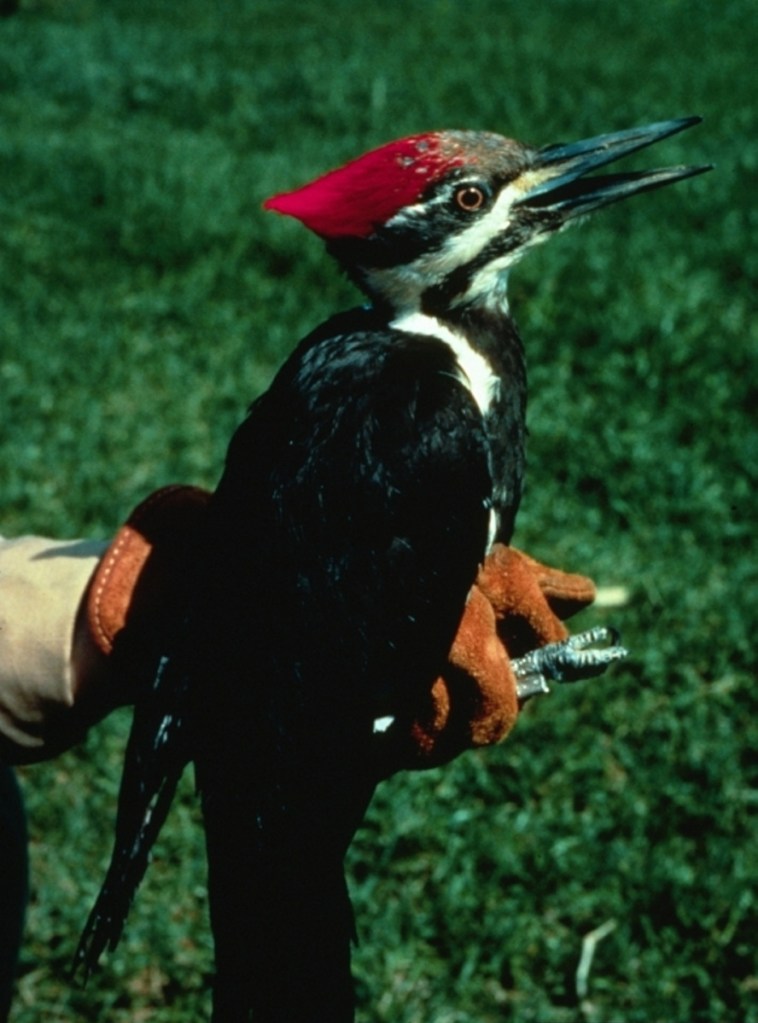A woodpecker’s drumming came filtering through the open May windows this morning. Its bouts came from just about due east of the living room, in among the spruces, maples, beeches and a huge white pine that must be 200 years old. The bird had no idea I was listening, of course. But the signals, whatever they were, seemed loud and clear.
It was almost certainly a yellow-bellied sapsucker. The drumming started out strong and even, got erratic, then trailed off. The pileated woodpeckers who also code messages into these woods drum a single roll with a heavy first few beats and then fading. That’s about the extent of my woodpecker-speak. That and the stray knowledge that the word “pileated” derives from the Latin pileatus, “capped,” and refers to the bright red crest on their heads. The birds don’t know that.
We also see northern flickers here off and on, patrolling the ground, and downy woodpeckers on tree trunks, with their black and white markings and small spot of red on top of the males’ heads. The others whose regular ranges include Maine are the red-bellied, red-headed (an unusual sight reported with a photo by a correspondent in the Waterville area), hairy, three-toed, and black-backed woodpeckers all less common to this part of Troy than pileated, downy and flicker.
Less common, I mean, according mainly to what’s picked up by my ear, which does not have perfect woodpecker pitch. The drumming patterns of these others seem less distinct. Different researchers have turned up different conclusions about them; one study found significant misidentifications based on drumming patterns of Nuttall’s and white-headed woodpeckers, and between ladder-backed and hairy woodpeckers. Another study even disputed earlier studies’ descriptions of the beats and cadences of downy and hairy woodpeckers’ drums. Northern flickers living in coniferous forests, it was observed, drum faster than those living in oak woods, and in some cases misidentifications could be ironed out, not by closer examination of the drumbeat, but by taking into account the habitat where it was happening.
Real birders (read: not me) can in general discern the drumming differences, though. And researchers have determined that while woodpeckers do bang trees and walls to forage for bugs and excavate nest holes, they drum specifically to communicate. Although there seems to be less certainty about what the woodpeckers are actually saying to each other than, for example, what chickadees are saying.
Woodpeckers signal by battering in two different ways: by drumming, when the woodpecker strikes “rapidly and repetitively,” and by tapping, when the bird strikes “regularly and at slower rates,” usually over shorter distances. Male red-bellied woodpeckers drum more during mating season when they’re trying to attract a partner. At other times, drumming seems related to territorial disputes. The red-bellied’s “kwirr” vocalizations seem to mean the same things but carry more information than drumming does in similar contexts. The drumming is, maybe, a kind of shorthand that the woodpeckers understand and we don’t.
Tapping occurs between male and female pairs early in their relationships, especially during the pre-nesting phase, when males and females “mutual tapped,” as the reports phrase it, often to call attention to a prospective site. The tapping seems to play a role in “pair bonding,” meaning red-bellied woodpecker couples identify and communicate with each other specifically.
In other words, it seems tapping is a form of domestic intimacy.
Anyway, complicated messages are being passed around out there among the trees. Usually we can’t see the birds, and we don’t know exactly what they’re saying. Whatever it is, it’s kind of beautiful. Which is no doubt part of the inherent meaning.
Dana Wilde lives in Troy. You can contact him at naturalist1@dwildepress.net. His recent book is “Summer to Fall: Notes and Numina from the Maine Woods” available from North Country Press. Backyard Naturalist appears the second and fourth Thursdays each month.
Send questions/comments to the editors.



Comments are no longer available on this story